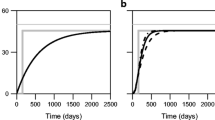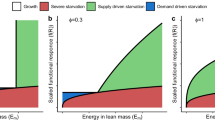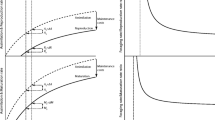Abstract
Body size (\(\equiv \) biomass) is the dominant determinant of population dynamical processes such as giving birth or dying in almost all species, with often drastically different behaviour occurring in different parts of the growth trajectory, while the latter is largely determined by food availability at the different life stages. This leads to the question under what conditions unstructured population models, formulated in terms of total population biomass, still do a fair job. To contribute to answering this question we first analyze the conditions under which a size-structured model collapses to a dynamically equivalent unstructured one in terms of total biomass. The only biologically meaningful case where this occurs is when body size does not affect any of the population dynamic processes, this is the case if and only if the mass-specific ingestion rate, the mass-specific biomass production and the mortality rate of the individuals are independent of size, a condition to which we refer as “ontogenetic symmetry”. Intriguingly, under ontogenetic symmetry the equilibrium biomass-body size spectrum is proportional to 1/size, a form that has been conjectured for marine size spectra and subsequently has been used as prior assumption in theoretical papers dealing with the latter. As a next step we consider an archetypical class of models in which reproduction takes over from growth upon reaching an adult body size, in order to determine how quickly discrepancies from ontogenetic symmetry lead to relevant novel population dynamical phenomena. The phenomena considered are biomass overcompensation, when additional imposed mortality leads, rather unexpectedly, to an increase in the equilibrium biomass of either the juveniles or the adults (a phenomenon with potentially big consequences for predators of the species), and the occurrence of two types of size-structure driven oscillations, juvenile-driven cycles with separated extended cohorts, and adult-driven cycles in which periodically a front of relatively steeply decreasing frequencies moves up the size distribution. A small discrepancy from symmetry can already lead to biomass overcompensation; size-structure driven cycles only occur for somewhat larger discrepancies.



Similar content being viewed by others
References
Andersen KH, Beyer JE (2006) Asymptotic size determines species abundance in the marine size spectrum. Am Nat 168(1):54–61
Anderson EC, Bell GI, Petersen DF, Tobey RA (1969) Cell growth and division IV. Determination of volume growth rate and division probability. Biophys J 9:246–263
Begon M, Harper JL, Townsend CR (1996) Ecology: individuals, populations and communities. 3rd edn. Blackwell Scientific Publications, Oxford
Bell GI (1968) Cell growth and division II. Conditions for balanced exponential growth in a mathematical model. Biophys J 8:431–444
Bell GI, Anderson EC (1967) Cell growth and division. I. A mathematical model with applications to cell volume distributions in mammalian suspension cultures. Biophys J 7:329–351
Brose U, Williams RJ, Martinez ND (2006) Allometric scaling enhances stability in complex food webs. Ecol Lett 9(11):1228–1236
Caswell H (2001) Matrix population models—construction, analysis and interpretation. 2nd edn. Sinauer Associates, Sunderland
De Roos AM (1988) Numerical methods for structured population models: the escalator boxcar train. Numer Methods Partial Differ Equ 4:173–195
De Roos AM (1997) A gentle introduction to physiologically structured population models. In: Tuljapurkar S, Caswell H (eds) Structured population models in marine, terrestrial and freshwater systems. Chapman-Hall, New York, pp 119–204
De Roos AM, Persson L (2003) Competition in size-structured populations: mechanisms inducing cohort formation and population cycles. Theor Popul Biol 63(1):1–16
De Roos AM, Persson L (2013) Population and community ecology of ontogenetic development. Monographs in Population Biology, vol 51, Princeton University Press, Princeton
De Roos AM, Metz JAJ, Evers E, Leipoldt A (1990) A size dependent predator-prey interaction: Who pursues whom? J Math Biol 28:609–643
De Roos AM, Schellekens T, Van Kooten T, Van De Wolfshaar K, Claessen D, Persson L (2007) Food-dependent growth leads to overcompensation in stage-specific biomass when mortality increases: the influence of maturation versus reproduction regulation. Am Nat 170:E59–E76
De Roos AM, Schellekens T, Van Kooten T, Van De Wolfshaar K, Claessen D, Persson L (2008) Simplifying a physiologically structured population model to a stage-structured biomass model. Theor Popul Biol 73(1):47–62
Diekmann O, Gyllenberg M, Metz JAJ, Thieme HR (1998) On the formulation and analysis of general deterministic structured population models - I. Linear theory. J Math Biol 36(4):349–388
Diekmann O, Gyllenberg M, Huang H, Kirkilionis M, Metz JAJ, Thieme HR (2001) On the formulation and analysis of general deterministic structured population models II. Nonlinear theory. J Math Biol 43(2):157–189
Diekmann O, Gyllenberg M, Metz JAJ (2003) Steady-state analysis of structured population models. Theor Popul Biol 63(4):309–338
Diekmann O, Gyllenberg M, Metz JAJ, Nakaoka S, de Roos AM (2010) Daphnia revisited: local stability and bifurcation theory for physiologically structured population models explained by way of an example. J Math Biol 61(2):277–318
Fredrickson AG, Ramkrishna D, Tsuchiya HM (1967) Statistics and dynamics of procaryotic cell populations. Math Biosci 1:327–374
Gurney WSC, Nisbet RM (1985) Fluctuation periodicity, generation separation, and the expression of larval competition. Theor Popul Biol 28(2):150–180
Kirkilionis MA, Diekmann O, Lisser B, Nool M, Sommeijer B, De Roos AM (2001) Numerical continuation of equilibria of physiologically structured population models. I. Theory. Math Models Methods Appl Sci 11(6):1101–1127
Kuznetsov YA (1995) Elements of applied bifurcation theory. Springer, Heidelberg
McCann K, Hastings A, Huxel GR (1998) Weak trophic interactions and the balance of nature. Nature 395(6704):794–798
McKendrick AG (1926) Application of mathematics to medical problems. In: Proceedings of the Edinburgh Mathematical Society, vol 44, pp 98–130
Metz JAJ, Diekmann O (1986) The dynamics of physiologically structured populations. Lecture Notes in Biomathematics, vol 68, Springer, Heidelberg
Metz JAJ, Diekmann O (1991) Models for physiologically structured populations. I. The abstract foundation of linear chain trickery. Lecture Notes in Pure and Applied Mathematics, vol 133, pp 269–289
Murphy LF (1983) A nonlinear growth mechanism in size structured population dynamics. J Theor Biol 104:493–506
Nisbet RM, Gurney WSC (1983) The systematic formulation of population models for insects with dynamically varying instar duration. Theor Popul Biol 23(1):114–135
Sheldon R, Prakash A, Sutcliffe W (1972) The size distribution of particles in the ocean. Limnol Oceanogr 17:327–340
Sinko JW, Streifer W (1967) A new model for age-size structure of a population. Ecology 48:910–918
Sinko JW, Streifer W (1969) Applying models incorporating age-size structure of a population to daphnia. Ecology 50:608–615
Sinko JW, Streifer W (1971) A model for populations reproducing by fission. Ecology 52:330–335
Tsuchiya HM, Fredrickson AG, Aris P (1966) Dynamics of microbial cell populations. Adv Chem Eng 6:125–198
Van Sickle J (1977) Analysis of a distributed-parameter population model based on physiological age. J Theor Biol 64:571–586
Von Foerster H (1959) Some remarks on changing populations. In: Stohlman F (ed) The kinetics of cellular proliferation. Grune and Stratton, New York, pp 382–407
Yodzis P, Innes S (1992) Body size and consumer resource dynamics. Am Nat 139:1151–1175
Acknowledgments
L. Persson is financially supported by grants from the Swedish Research Council and the Swedish Research Council for Environment, Agricultural Sciences and Spatial Planning. The work of Hans Metz benefitted from the support from the “Chair Modélisation Mathématique et Biodiversité of Veolia Environnement-Ecole Polytechnique-Museum National d’Histoire Naturelle-Fondation X”.
Author information
Authors and Affiliations
Corresponding author
Additional information
This article is dedicated to Odo Diekmann, who provided so many of the building blocks for its contents.
Appendix: The explicit expressions for \(\gamma _i\) and \(\alpha _i\) and \(\frac{d\tilde{R}}{dm}\)
Appendix: The explicit expressions for \(\gamma _i\) and \(\alpha _i\) and \(\frac{d\tilde{R}}{dm}\)
In this appendix we give the missing ingredients of formulas (48a) and (48b).
Determining the derivative \(d\tilde{R}(m)/dm\) using the implicit function theorem after substitution of \(d_{J}+m\) and \(d_{A}+m\) for \(d_{J}\) and \(d_{A},\) respectively, in Eq. (44) leads to
Rights and permissions
About this article
Cite this article
De Roos, A.M., Metz, J.A.J. & Persson, L. Ontogenetic symmetry and asymmetry in energetics. J. Math. Biol. 66, 889–914 (2013). https://doi.org/10.1007/s00285-012-0583-0
Received:
Revised:
Published:
Issue Date:
DOI: https://doi.org/10.1007/s00285-012-0583-0
Keywords
- Physiologically structured population
- Ontogenetic symmetry
- Size-structure
- Biomass overcompensation
- Population cycles
- Size spectrum




